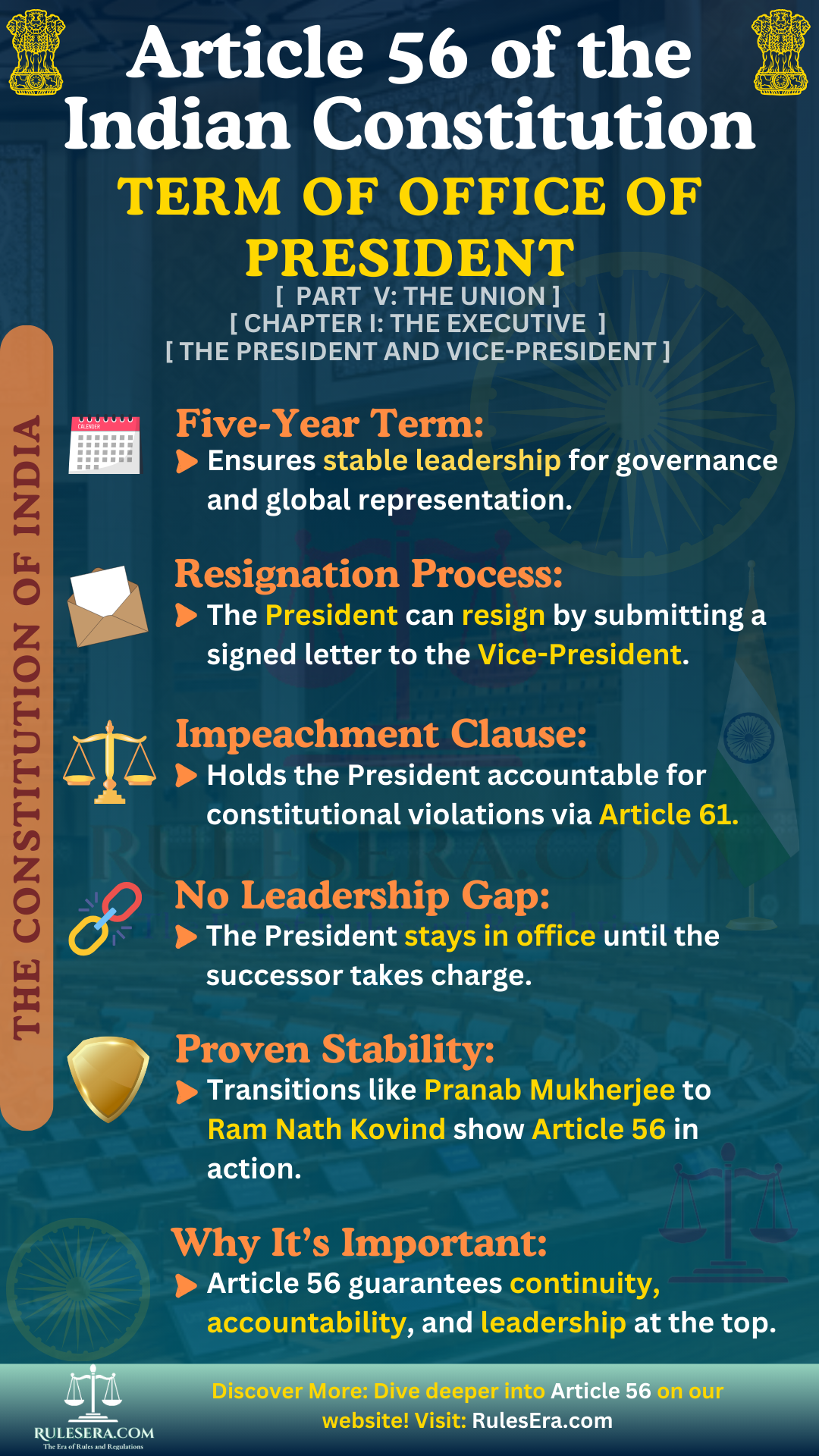Part V: The Union
Chapter I: The Executive
Article 56: Term of Office of President

--- Original Article ---
(1) The President shall hold office for a term of five years from the date on which he enters upon his office: Provided that—
- (a) the President may, by writing under his hand addressed to the Vice-President, resign his office;
- (b) the President may, for violation of the Constitution, be removed from office by impeachment in the manner provided in article 61;
- (c) the President shall, notwithstanding the expiration of his term, continue to hold office until his successor enters upon his office.
(2) Any resignation addressed to the Vice-President under clause (a) of the proviso to clause (1) shall forthwith be communicated by him to the Speaker of the House of the People.
Explanation
Article 56 of the Indian Constitution defines the length of the President’s term, the conditions under which the President may resign, be impeached, or remain in office until a successor assumes charge. This article upholds the principles of continuity and stability at the highest level of executive power in India.
Key Provisions
- Presidential Term (Clause 1): The President is elected for a five-year term, ensuring consistent leadership and providing enough time to contribute meaningfully to governance.
- Voluntary Resignation (Clause a): The President has the right to resign by submitting a letter to the Vice-President, which is then forwarded to the Speaker of the Lok Sabha.
- Impeachment for Violating the Constitution (Clause b): The President can be impeached for violating the Constitution, as detailed in Article 61, requiring a resolution passed by two-thirds of Parliament.
- Continuation in Office Until Successor (Clause c): The President remains in office until their successor assumes the role, even if their term has officially ended, ensuring no gap in leadership.
Amendments and Real-Life Examples
- Amendments: Article 56 has not been amended, and its original provisions have effectively governed all presidential transitions in India.
- Real-Life Example: In 2017, when Pranab Mukherjee’s term ended, Ram Nath Kovind was elected as the new President. Mukherjee continued to hold office until Kovind assumed the role, ensuring a seamless transition.
Historical Significance
The provisions of Article 56 reflect the continuity and stability required in the office of the President. The article ensures that transitions are smooth, without a vacuum in leadership, while also incorporating safeguards like impeachment for accountability.
Legislative History
Article 56, originally drafted as Article 45, was deliberated and incorporated into the Indian Constitution on December 13, 1948.
Debates and Deliberations
During the Constituent Assembly debates on Article 45 (now Article 56), Mr. Mohd. Tahir proposed an amendment suggesting that in case of a casual vacancy, the new President's term should align with the remaining term of Parliament. His reasoning was that this would prevent the President from influencing future elections. However, Dr. B.R. Ambedkar and Shri T. T. Krishnamachari countered this by stating that the article already provided for a clear five-year term, and Tahir's amendment was redundant.
Mr. Naziruddin Ahmad proposed renaming the "House of the People" to "National Congress" to honor the role of the Congress Party in India's independence. This suggestion was opposed by Shri T. T. Krishnamachari, who pointed out that the Congress Party still existed, and such a renaming could create confusion and be politically inappropriate.
Shri B. M. Gupte proposed an amendment suggesting that the President should submit his resignation directly to the Vice-President rather than both the Speaker and the Chairman of the Rajya Sabha. This proposal was accepted, with the additional requirement that the Vice-President must inform the Speaker of the resignation.
Giani Gurmukh Musafir suggested adding "or of law" to the impeachment clause, to specify that violations of law should also be grounds for impeachment. This suggestion was rejected by the Assembly, as it was felt that the phrase "violation of the Constitution" already covered breaches of law. Mr. Naziruddin Ahmad also proposed adding "or resignation as the case may be" to the resignation procedures, but this was similarly rejected.
Ultimately, the Constituent Assembly adopted Article 45 with minor amendments, affirming the fixed five-year term for the President and the mechanisms for resignation and impeachment as initially drafted by the committee.
Frequently Asked Questions (FAQs):
The President of India holds office for a term of five years, as specified in Article 56 of the Constitution.
Yes, the President can resign before completing their term by submitting a written resignation to the Vice-President, who then communicates it to the Speaker of the Lok Sabha.